The July 2013 Federal Reserve's Industrial Production & Capacity Utilization report shows no change in industrial production. Manufacturing alone declined -0.1% for the month. Utilities dropped -2.1% and is the 4th monthly decline in a row. The G.17 industrial production statistical release is also known as output for factories and mines. The graph below shows industrial production index, still not recovered to pre-recession levels, going on five years and seven months.
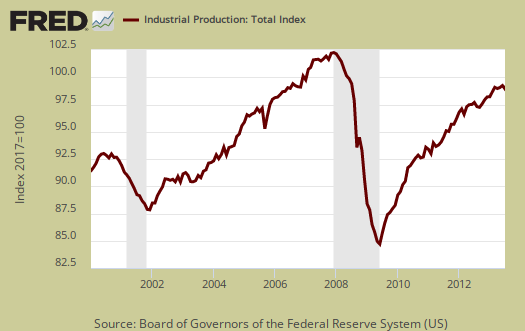
The second quarter showed Industrial production at a Q3 2012 low and this month starting off the third quarter is no better. Industrial production does have some correlation to GDP components, but not always, so this month's no change is just more bad news for industrial production. The below graph is the industrial production index by quarters, up to Q2 2013.
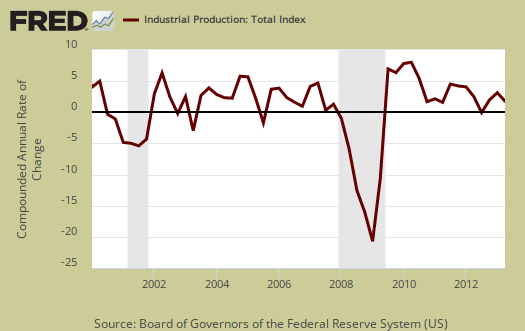
Total industrial production has increased 1.4% from a year ago and is still down -1.1% from 2007 levels, that's over half a decade. Here are the major industry groups industrial production percentage changes from a year ago.
- Manufacturing: +1.3%
- Mining: +5.7%
- Utilities: -3.7%
Manufacturing output alone shows a -0.1% monthly change. Below is a graph of just the manufacturing portion of industrial production.
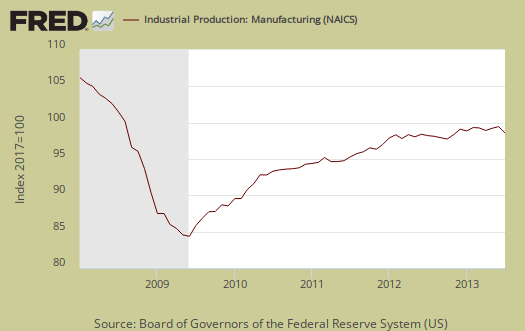
Durable goods decreased -0.2% for the month and has barely budged since February. This month primary metals shot up 2.6% but could not wipe out the dramatic decrease in motor vehicles & parts output, a decline of -1.7% for the month.
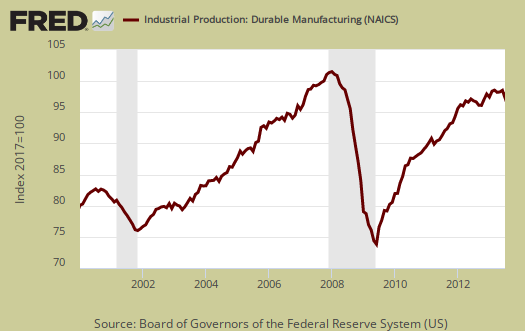
Nondurable goods manufacturing flatlined, unchanged for the second month in a row. Printing and support were the culprits with a -1.2% decline. Food & beverages also declined -0.5% while Petroleum and coal shot up 2.0% for the month. The decline in printing generally speaking should be a technological shift, as more and more people utilize digital media.
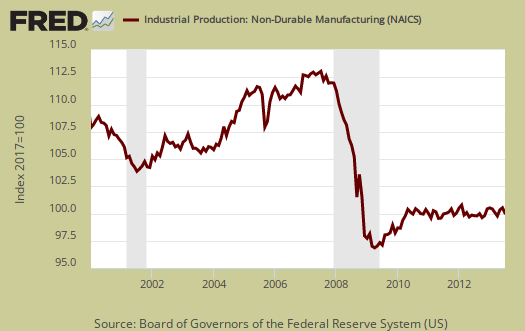
Mining has really grown in the United States, primarily on oil and gas extraction. Mining is also fueling the North Dakota economic miracle.
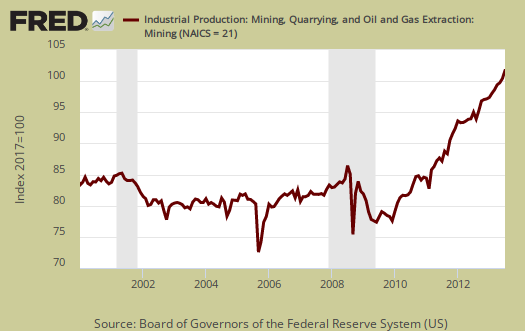
Utilities are another story and notice how declines in utilities align with recessions and also how, even though seasonally adjusted, there is quite a bit of variance month to month. Businesses, needless to say, utilize utilities.
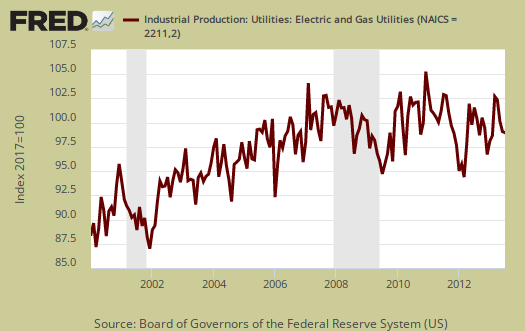
There are two reporting methodologies in the industrial production statistical release, market groups and industry groups. Market groups is output bundled together by market categories, such as business equipment or consumer goods. Industrial output is by NAICS codes and is for all manufacturing, or all types of durable goods manufacturing*. Below is the Fed's description of Market groups from the report and their monthly percent changes. Looks like automotive is the bright spot in the otherwise dreary industrial production figures.
The production of consumer goods decreased 0.5 percent in July after having increased 0.6 percent in June; in July, the index stood 1.3 percent above its year-earlier level. The production of durable consumer goods fell 1.5 percent; within consumer durables, automotive products posted a loss of 2.4 percent, while all other indexes moved down between 1/2 and 1 percent. The index for consumer nondurables contracted 0.2 percent. The output of non-energy nondurables decreased 0.4 percent, with losses in the indexes for foods and tobacco, for chemical products, and for paper products. After having fallen in the previous three months, the output of consumer energy products moved up 0.3 percent, as increases in petroleum refining more than offset lower sales of electricity to residences.
The index for business equipment was unchanged in July and stood 2.1 percent above its year-earlier level. In July, the index for transit equipment was unchanged, the production of information processing equipment decreased 0.7 percent, and the index for industrial and other equipment edged up 0.2 percent.
The output of defense and space equipment advanced 1.0 percent in July. The increase in July was the first gain for the index since December 2012. The cumulative decline over the first six months of the year was 2.3 percent.
In July, the output of construction supplies advanced 0.5 percent for a second consecutive month and, despite large swings over the past year, stood 4.4 percent above its level of a year earlier. The production of business supplies declined 0.7 percent in July and was 0.5 percent below its year-earlier level.
The production of materials to be processed further in the industrial sector moved up 0.4 percent in July and stood 1.7 percent above its year-earlier level. The output of durable materials edged up 0.2 percent in July, as a decline for equipment parts was outweighed by increases for consumer parts and for other durable materials. The production of nondurable materials moved down 0.5 percent as a result of losses for textile, paper, and chemical materials. The output of energy materials advanced 1.2 percent on the strength of gains in oil and natural gas extraction; in July, the index for this market group was 3.5 percent above its level of a year earlier.
Below is graph of overall industrial production's percent change from a year ago. The Federal Reserve gives long term averages but economic malaise has been going on so long, 2008-2012 are part of those averages now.

Capacity utilization, or of raw capacity, how much is being used, for total industry is 77.6%, now 2.6 percentage points below the average from 1972 to 2012. Capacity utilization has decreased -0.3 percentage points from a year ago and declined -0.1 percentage points for the month. Manufacturing capacity utilization is now 75.8% and is 0.2 percentage points lower than a year ago. Mining capacity utilization is 89.5% and is up 1.3 percentage points from a year ago. Utilities use if it's capacity is 76.2% and this is a decline of -3.8 percentage points from a year ago. Manufacturing capacity utilization declines are not good news. Utilities are electricity and gas and there are large inventories as of late stock piling up as milder weather plus alternative energy have greatly reduced demand.
Capacity utilization is how much can we make vs. how much are we currently using, of what capacity is available now, or output rate. It is also called the operating rate. Capacity utilization is industrial production divided by raw capacity.

Capacity growth is raw capacity and not to be confused what what is being utilized. Instead, this is the actual growth or potential to produce. Capacity is the overall level of plants, production facilities, and ability to make stuff, that we currently have in the United States. Capacity growth overall has increased 1.8 percentage points from a year ago, the same as last month Below is the capacity growth increase from a year ago of the subcategories which make up industrial production.
- Manufacturing: +1.5%
- Mining: +4.1%
- Utilities: +1.1%
According to the report for 2012, manufacturing uses 77.4% of capacity, with durables about 39.7%. Utilities use 9.9% and mining 12.7% in 2012 (rounded) to give a ratio of manufacturing vs. mining and utilities in terms of capacity. High tech uses 3.7% of total industrial production capacity. Below is the Manufacturing capacity utilization graph, normalized to 2007 raw capacity levels, going back to the 1990's. Too often the focus is on the monthly percent change, so it's important to compare capacity utilization to pre-recession levels and also when the economy was more humming.
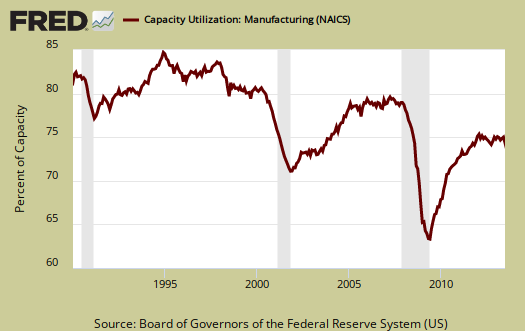
Here are our previous overviews, only graphs revised. The Federal Reserve releases detailed tables for more data, metrics not mentioned in this overview. If you are baffled by what crude, finished mean from the G.17 report, read these stages of production definitions. Stages of production have implications for exports and imports. Finishing industrial production implies goods for final sale and thus what kind of output one will see for the month. From the report:
Capacity utilization rates in July for industries grouped by stage of process were as follows: At the crude stage, utilization increased 0.9 percentage point to 87.4 percent, a rate 1.1 percentage points above its long-run average; at the primary and semifinished stages, utilization declined 0.2 percentage point to 75.5 percent, a rate 5.5 percentage points below its long-run average; and at the finished stage, utilization moved down 0.5 percentage point to 75.6 percent, a rate 1.5 percentage points lower than its long-run average.
*From the Federal Reserve definition details:
Market groups consist of products and materials. Total products are the aggregate of final products, such as consumer goods and equipment, and nonindustrial supplies (which are inputs to nonindustrial sectors). Materials are inputs in the manufacture of products. Major industry groups include three-digit NAICS industries and aggregates of these industries-for example, durable and nondurable manufacturing, mining, and utilities./blockquote>

Recent comments